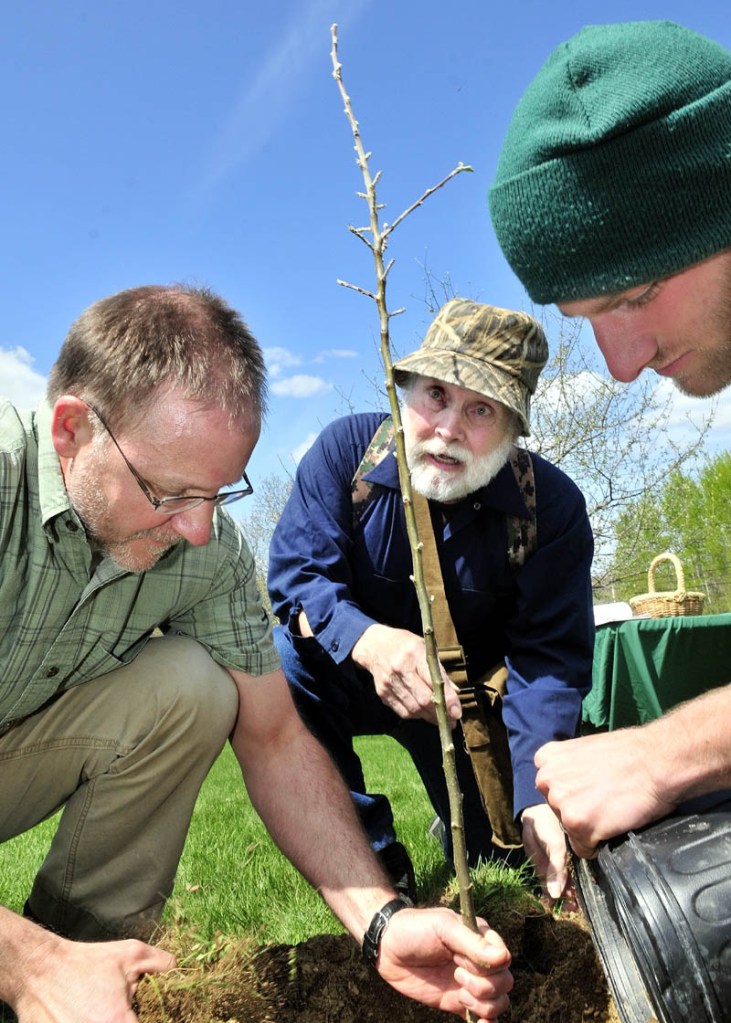UNITY — A sapling from famed American pioneer Johnny Appleseed’s original apple tree lineage is growing on Quaker Hill.
John Chapman, great-great-great-great-great-grandnephew of John Chapman, the original Johnny Appleseed, presented the sapling Thursday to Unity College.
“We need to pass on the passion of nature to the younger generation,” said Chapman, who is a 1974 Unity wildlife management graduate.
“We need to (do so) to survive.”
The white-bearded 63-year-old wore a camouflage hat and suspenders, a blue shirt and jeans for the sunny afternoon ceremony attended by students and faculty.
The 3-foot-tall sapling was placed in the orchard next to Quaker Hill Road, where students planted two dozen apple trees on Earth Day in 1997.
Appleseed, who was born in 1774 in Massachusetts, was a young boy when the American colonies won independence from England; his father was a Minuteman in the Continental Army.
In the 1800s, Appleseed’s fame grew as he walked barefoot around the countryside, spreading seeds in Ohio, Indiana and Illinois.
Chapman said Appleseed found rich plots of land, planted seeds he had obtained from pressed apples, and used brush to fence in the areas.
When Appleseed continued on his journey, he tapped others to tend the nurseries.
The fruit helped feed pioneering settlers making their way westward and produced potent hard cider.
Chapman joked that farmers’ wives sometimes didn’t appreciate Appleseed because of the way the cider affected their husbands.
“He was a character,” Chapman said of Appleseed. “He was a friend to Indians and frontiersmen.”
Chapman related several stories that relatives had shared with him about his famous ancestor.
He said Appleseed was once sleeping in a hollow log when a mother bear ambled along.
“He got out of the log and let the bear and her cubs stay there,” he said.
Appleseed, a vegetarian, also freed a wolf from a trap; and for a time, the wolf was his pet, Chapman said.
“He regretted that he killed a rattlesnake one day that had struck out at him,” said Chapman, who has 26 pet snakes.
Chapman brought one of those pets — a female black milk snake from Mexico — to the ceremony.
Chapman, who lives in Athens, said he donated the sapling to help ensure the survival of Appleseed’s apple lineage.
He said he obtained a scion of the original lineage from a nursery in Jeromesville, Ohio.
Chapman said he was teased a bit as a child about being related to Appleseed.
“But it was taught in schools then,” he said. “I don’t know if it’s taught anymore. We were out in frog ponds, and today kids play computer games.”
Like his legendary ancestor, Chapman said he appreciates nature.
“If you don’t have to worry about getting eaten, you’re not in nature,” he said.
Doug Fox, professor of landscape horticulture at Unity and director of the Center for Sustainability and Global Change, called the sapling “a very special addition to the orchard.”
Beth Staples — 861-9252
bstaples@centralmaine.com
NUGGET:
More than 100 varieties of apples are grown in Maine; the Black Oxford and Brock varieties originated here. Eighty-four farms on 2,000 acres annually produce about 1 million bushels of apples in the state. An apple tree generally bears fruit in two to 10 years.
Source: Maine Pomological Society
Copy the Story Link
Send questions/comments to the editors.



Success. Please wait for the page to reload. If the page does not reload within 5 seconds, please refresh the page.
Enter your email and password to access comments.
Hi, to comment on stories you must . This profile is in addition to your subscription and website login.
Already have a commenting profile? .
Invalid username/password.
Please check your email to confirm and complete your registration.
Only subscribers are eligible to post comments. Please subscribe or login first for digital access. Here’s why.
Use the form below to reset your password. When you've submitted your account email, we will send an email with a reset code.